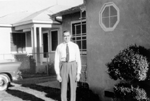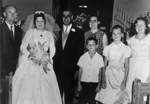| In 1955, at the invitation of the Disciples
of Christ Church, I was privileged to represent the Christian Youth Federation
of Lebanon and Syria at a work camp and youth conference in the state of
Indiana. Because of my interest in the field of audiovisuals, and since
the field was almost unknown in our part of the world, Reverend Hal Fisher
and the American Presbyterian Mission in the Middle East recommended that
I attend the 12th International Conference on Audio Visuals
in the Church that was to be held in Green Lake, Wisconsin, in early September
of 1955. It was Hal’s hope that when his tour of duty ended, a national
(maybe me) would take his place as director of the
audiovisual program.
At the A-V Conference I met Glenn McMurry, who, at that time was the Director of Audiovisual Services of the Department of Cinema, University of Southern California. Glenn was also consultant to the Television, Radio and Film Commission of the Southern California-Arizona Conference of the Methodist Church. After the Conference, I went to Chicago and stayed at the YMCA. At the Y I was happy to find out that Glenn and a friend (also a delegate representing the Southern California-Arizona Conference) were staying there. We went to dinner and had a delightful evening. When we parted Glenn said, "Let us hear from you when you go back to your country, and please let me know if there is anything I can do for you. After my return to Lebanon, I learned that Congress had authorized a special quota for 2000 Palestinians and their families to immigrate to the US. In the 1950’s the immigration law stated that the place of birth rather than the nationality of a person determined his eligibility to apply under a country’s quota. Even though I was a Lebanese citizen (so were my parents and grandparents), because of my father’s business we lived in Palestine at the time of my birth. This made me eligible to apply provided I had a sponsor and job in the States. I remembered Glenn’s words in Chicago, so I wrote him a letter and explained to him how it would be possible for me to emigrate under the special quota. True to his word, Glenn offered to help and even offered to give me a job working for him in the Audiovisual Department at USC. I applied for my visa on February 16, 1956, and it was granted in November of that year. I arrived in Los Angeles the morning of January 4, 1957. Glenn and Darlene and their children, Glenda, Jean and Greg, were gracious enough to let me share their home while I got my bearings, and in June I moved to a room on campus. I never for a moment felt like anything but a member of the family. This was also true of Glenn's folks back on the farm in Hutchinson, Kansas. I visited there on more than one occasion, once with my new bride, and was always treated royally. On January 7, 1957, I started my job working for Glenn at USC. I am sure I must have frustrated him many times during the years he was my boss, but nothing compares to my frustration the second day on the job when he sent me on an errand and gave me directions to go past "Tommy Trojan." Now in those days "Tommy Trojan" was as foreign to me as Chinese is now. Embarrassed to ask and show my ignorance I started praying - my prayers were answered when I stopped to read the inscription, "The Trojan", on a statue in the middle of the campus. (Ah! That must be "Tommy".) That was not the last time Glenn talked to me in a "foreign" language, but by then I was not embarrassed to ask him to explain.
Glenn’s mind worked like a computer. I remember the day he and I went to a computer show at the Ambassador Hotel on Wilshire Blvd. to look at the bulky tab machines and keypunch machines (now my little Mac can do more than those machines that filled up a whole room). Glenn was so excited, "We can make our film catalog for a fraction of the cost by putting our titles on punch cards." That again was Chinese to me. Glenn applied for a grant from the federal government to study the feasibility of cataloging by computer. That’s how the automated catalog project started and evolved into the National Information Center for Educational Media. Glenn and Darlene were the chief investigators on the project putting in long hours at the office and at home. However, they never let their disagreements about running the project interfere with their dedication to each other. Taking on the new project, Glenn turned more of his university responsibilities over to me, and when Glenn accepted Uncle Sam’s call to go to Washington, I was given the job he held at USC. I must say here that because of Glenn’s association with the Methodists, I used to accompany him to Methodist headquarters. At the Methodist Bookstore, which was located on the first floor, I met my future wife. On August 20, 1995, we celebrated our 35th anniversary. I retired from USC in May, 1992. At the retirement dinner my wife and our two daughters gave for me at the Faculty Center I thanked the McMurry's for taking the risk of sponsoring someone they had known for only a few hours. Now I want to put in writing: THANK YOU, Glenn and Darlene! PS. Dear Glenn and Darlene,Happy 50thAnniversary. Mary and I wish you many more in good health. Forever Grateful, George |



